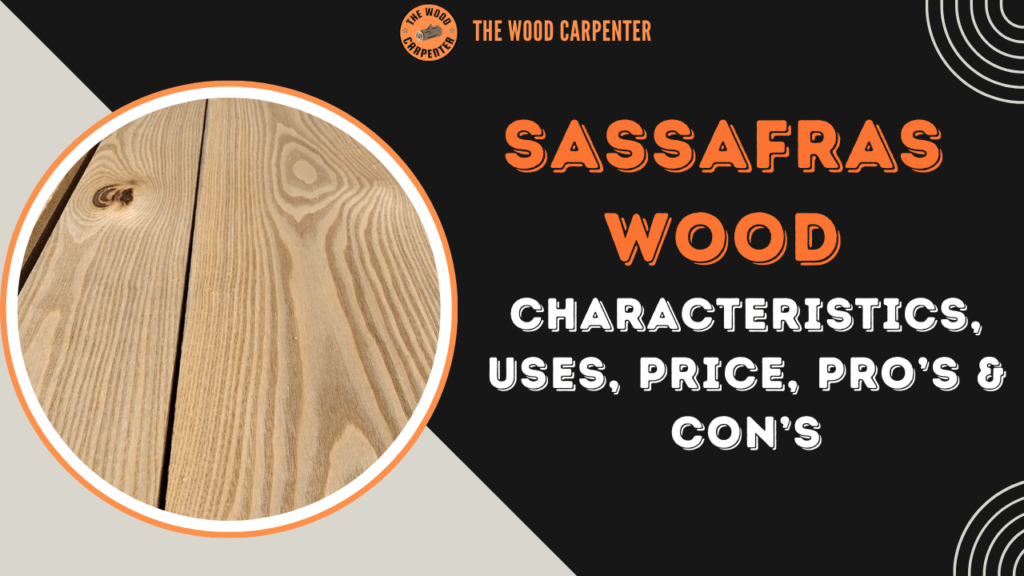
As far as fragrant hardwoods go, not many grab understatedly like sassafras wood. Known for its spicy root-beer scent, unique grain and superb workability, sassafras has been treasured for centuries in both North America and Australia. It is still preferred today by furniture builders, cabinetmakers, boat builders and antique restorers.
In this guide, we will take a deep dive into all things sassafras wood — types of sassafras, its properties, advantages and how you can use it, cost and even a little historical trivia that makes this hardwood unique in the wood world.
What Is Sassafras Wood?
The name sassafras is applied to two distinct trees:
North American Sassafras (Sassafras albidum) – This is what most woodworkers are referring to when they use the term sassafras, it is found in the eastern United States.
Australian Sassafras (Doryphora sassafras) – Native to New South Wales rainforests, Australian Sassafras is a timber with properties of its own, and is used for cabinetry, veneers and tool handles.
Despite their identical name, these are not related trees. Although either produce wood that is soft, light-weight and sought after for their aromatic and aesthetic properties.
Physical Characteristics
Appearance
North American Sassafras: Heart wood light to medium brown with reddish or olive hues on some specimens. Heartwood is pale yellow brown and not always well-defined. This grain is usually straight-grained, coarse and irregular—like that of ash or chestnut.
Australian Sassafras: Heartwood varies from yellowish grey to chocolate brown with straight grain, has an even texture. A type of eucalyptus called blackheart sassafras, with dark streaks, is particularly valued for decorative purposes.
Weight and Density
North American sassafras is a lightweight wood with an average specific gravity of ~0.495 It is also easy to work and to keep it once dried.
Australian sassafras is denser (~590 kg/m³ seasoned) for a slightly harder feel and more robust properties.
Smell of Sassafras Wood
One of the most fascinating features of this sassafras wood is that it has a clean, spicy aroma very similar to root beer or cinnamon. It smells strongest when freshly cut or sanded, which makes the woodworkers to love this wood.
Mechanical Properties
Hardness: North American sassafras is a softer wood with a Janka rating of 630 lbf (2,800 N), less hard than oak and harder than poplar, which makes it suitable for beginners.
Strength: While not strong enough for structural applications (MOR 9,000 psi — MOE 1.12 Mpsi), it’s still impressive with regard to cabinet/furniture use.
Shrinkage & Stability: Shrinkage is rather low (radial 4%, tangential 6.2%), which provides good dimensional stability. Australian sassafras is even better, with reduced shrinkage rates (radial 2.2%, tangential 5.8%).
Durability and Workability
Durability
Rot Resistance: Heartwood is rated as durable to very durable in regard to decay resistance, and is also resistant to insect attack; this weakly aromatic wood is often used in outdoor applications, such as fencing or exterior trim, where it can last for decades.
Australian sassafras – It is not as resistant to rot, however, it works well inside and fire resistance ratings for construction in bushfire-prone areas are high.
Workability
Both red and white sassafras are counted among the easily worked woods, being cut, planed, nailed and sawed with comparative ease. They also work well when cut, glue up tidy and can even take stains and finishes gorgeously.
One downside is that because Sassafras can be a bit brittle, you may get some splintering or tear-out. This can be avoided by closely paying attention to the grain direction, and also making sure that the tools are sharp.
Screws hold tight but would split if not pre-drilled..
Historical and Modern Uses
Sassafras has a long and fascinating history:
⦁ Colonial America: Roots and bark were boiled into “medicinal” teas thought to cure ailments ranging from headaches to syphilis. The wood was also used for bed frames, as people believed its aroma repelled bedbugs.
⦁ Traditional Uses: Barrels, fence posts, gates, and small boats often used sassafras for its durability and workability.
Modern Applications:
⦁ Furniture & Cabinetry – Stable, lightweight, and attractive.
⦁ Outdoor Projects – Great for posts, rails, and decking due to rot resistance.
⦁ Turnings & Carvings – Easy to shape and sand.
⦁ Veneer & Decorative Work – Especially prized in its Blackheart variation.
⦁ Restoration Work – Antique restorers use sassafras as a substitute for chestnut.
Pricing and Availability
⦁ In North America, sassafras boards are typically available in 4/4 and 8/4 thicknesses, with prices averaging $4–$5 per board foot—cheaper than oak or walnut.
⦁ Veneers are occasionally available online, though sassafras plywood is rare.
⦁ In Australia, Australian sassafras is commercially available, harvested from native forests mainly in New South Wales and is relatively reasonably priced particularly for veneer and craft work.
Sassafras Oil
Derived from the roots and bark, sassafras oil is known to contain safrole, a substance associated with health risks. It was once used in teas and medicines, it is now restricted because of its toxicity.
Safety and Toxicity
Although dust from sassafras is not particularly poisonous, it can be a sensitizer causing slight nausea and irritation of the respiratory system in some people. Safrole, the essential oil obtained from its roots and bark, is toxic and weakly carcinogenic by ingestion. Always use dust protection and ventilate properly when working with sassafras.
Advantages of Sassafras Wood
- Lightweight yet durable
- Superb decay-resistance (North American species)
- Stable with low shrinkage
- Can be cut, carved, glued, and finished with ordinary woodworking–blades and adhesives.
- Cheap and common in some areas
- Distinctive aroma and natural beauty
- Historically valued and culturally significant
Disadvantages of Sassafras Wood
- Light strength—it is not recommended for load bearing structures.
- Smaller tree sizes may result in some board widths being narrow or short
- May splinter or tear out if tools are dull or grain is not appropriately oriented
- Plywood or specialty cutouts not readily available
- Potential allergen for sensitive users
Frequently Asked Questions (FAQs)
1. Is sassafras wood valuable?
Yes. While it is not as expensive as oak or walnut, sassafras is valued for its durability, workability, and unique aroma.
2. Is sassafras good for outdoor use?
North American sassafras is rot-resistant and it performs well outdoors in posts, rails, and small boats.
3. How does sassafras compare to other woods?
It resembles ash and chestnut in grain and texture but is lighter and more aromatic. Australian sassafras offers finer texture and better structural strength.
4. Is sassafras wood safe?
Yes for woodworking, though dust protection is recommended. The essential oil in roots and bark should not be ingested.
5. What is Blackheart sassafras?
A decorative type from Tasmania, sought after for its darker streaks and figure, used for veneer and fine furniture.
6. Is Sassafras Still Used in Root Beer?
No. Sassafras root was a traditional ingredient in old-fashioned root beer, but it was outlawed in the 1960s after safrole (its oil) was deemed toxic and carcinogenic.
7. What Does Sassafras Smell Like?
The wood of sassafras has a scent somewhat similar to root-beer when cut and sanded, it generally reminds people of cinnamon or licorice.
8. Is Sassafras Good Wood?
Yes. It’s light, strong, rot resistant and easy to work with which is why it makes a good choice for furniture or outdoor projects especially when price is a factor.
9. Is Sassafras Hardwood or Softwood?
The wood is a hardwood, but it is not as hard as the oak or walnut.
10. Why Is Sassafras Not Used Anymore?
While it is still used in woodworking, sassafras is not used for foods or medicines — one of its oil’s compounds, called safrole, is toxic and only weakly carcinogenic.
Final Thoughts:
Sassafras may not shine in the limelight like walnut or oak, but Sassafras is a silent hero of all wood. Being a light weight, stable, as well as easy-to-work wood with rot resistance and good smell, it is popular to beginners and woodworking masters alike.
Whether you are refinishing a vintage find, or creating antique furnishings, your woodworking project deserves a wood that is as beautiful as it is useful — sassafras is the best option when you want to lend your work history and character.

